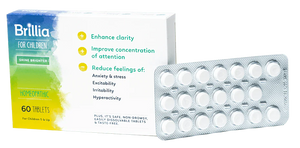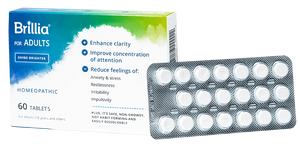While many of us feel shy or intimidated on occasion, especially when meeting new people, social anxiety is far more intense and even debilitating, qualifying it as a mental health condition in the DSM-5. Something as simple as making small talk with a barista at the local coffee shop or attending a holiday party with work colleagues can send a person with social anxiety into a panic, presenting both mental and physical symptoms. According to the Anxiety & Depression Association of America, social anxiety affects an estimated 15 million adults, or around 6.8% of the U.S. population.1 The mental health condition also affects children, with symptoms typically emerging around age 13.
To make matters worse, many experts are now pointing out that the COVID-19 pandemic has increased rates of social anxiety. More and more people are having difficulty returning to their social lives after enforced lockdowns kept them at home and isolated for an extended period of time. The transition feels jarring. If you or a loved one is suffering from social anxiety, explore our guide to understanding this mental health condition, learn the importance of keeping contact with others even when it feels uncomfortable, and find tips to make the transition to socializing more bearable.
What is Social Anxiety?
According to the DSM-5, social anxiety is characterized by having a marked fear or anxiety about one or more social situations in which the individual is exposed to potential scrutiny by others.2 This includes such everyday situations as having a conversation, meeting unfamiliar people, being observed, and performing in front of others. The anxiety is almost always out of proportion to the actual threat posed by the social situation and to the sociocultural context.
Common signs and symptoms of social anxiety occur frequently and include:
- Fear of situations in which you may be judged or scrutinized
- Persistent worry about embarrassing yourself
- Fear of appearing anxious to others
- Fear of of interacting or talking to others
- Anxiety in advance of social situations
- Ruminating about your behavior after social situations
- Difficulty making eye contact
- Avoidance of social gatherings, work or school, dating, and public places
- Physical symptoms such as blushing, sweating, trembling, dizziness, racing heart, feeling like your mind has gone blank, and having an upset stomach
Children with social anxiety may show even more signs such as crying, having tantrums, clinging to parents, or refusing to speak.
The Importance of Keeping Social Contact
For socially anxious people, avoiding such triggering situations like a party, a work event, or maybe a date, can bring relief. However, while avoidance may be comforting in the short-term, unaddressed social anxiety will only continue to flare up and maybe even worsen in the long term. As terrifying as it may sound, keeping social contact is the best way to overcome social anxiety. In cognitive behavioral therapy (CBT), many experts use exposure therapy to help their socially anxious clients become more social. By gradually exposing oneself to feared situations like attending a party, going on a date, or starting a conversation, individuals fear these situations less and learn that social catastrophes are unlikely to happen.
Even more confronting is the practice of social mishap exposures, in which socially anxious people are asked to intentionally create the feared negative consequences of a feared social situation. For instance, if a person avoids the subway because they are afraid of embarrassing themselves in the moving vehicle, they may be asked to sing or dance on the subway. Studies show that after such an out-of-character experience, the individual realizes that “social mishaps do not lead to the feared long-lasting, irreversible, and negative consequences.”3
How COVID Has Perpetuated Social Anxiety
Staying home and avoiding social gatherings during the COVID-19 pandemic became a way of life. Now that social distancing measures are loosening, social anxiety is tightening its grip around those who don’t feel quite ready to interact with others. It’s almost as if their social skills have gone rusty after too many months of neglect. Experts advise that individuals suffering with COVID-related social anxiety take it slow and ease back into socializing instead of filling your social calendar to make up for lost time. Remind yourself that almost everyone is learning how to return to “normalcy” and have more and more face-to-face interactions off Zoom. Be gentle on yourself and others as you grapple with anxiety-fueling questions like “Is it OK to shake hands now?” or “Am I standing too close?”
Tips on How to Reduce Social Anxiety Symptoms
As we said before, avoiding social situations only brings temporary relief. Exposing yourself to social situations is the best way to ease your anxiety for good. If you’re struggling with social anxiety symptoms, try the following tips:
- Become mindful of your breathing: When you are feeling socially anxious, it’s common for your breathing to become fast and shallow. But this kind of breathing will likely make you feel more anxious. Practicing breathing exercises on a regular basis will help you get in the habit of paying attention to the breath and controlling it in triggering situations. Focusing on the breath also allows you to be more present and place your attention on bodily sensations instead of racing thoughts in your mind.
- Prepare: If you are worrying about an upcoming event, prepare yourself beforehand. If your fear is making conversation, for instance, come up with a few topics you can use, maybe based on the latest news stories. If you have a presentation at work, recite the presentation several times, ideally in front of another person, before the big day.
- Exercise regularly: So much of our anxiety is fueled by pent up energy. Some experts suggest exercising before a social event to deplete some of this energy, get feel-good hormones pumping, and feel more at ease around others.
- Challenge negative thoughts: Socially anxious thoughts are typically irrational. Challenge them by first identifying the thoughts that come up, question why you think like this, and practice positive self-talk to replace negative thoughts.
- Focus on the other person: It’s important to remember that when you’re interacting with someone, they’re responsible for the interaction as well. It’s not entirely up to you to keep the conversation going. Taking the focus off yourself and your fears and considering the other person is a great way to get out of your head and into the moment.
- Adopt a healthier lifestyle: Eating well and getting enough sleep simply makes us feel better. You may feel more anxious than usual if you downed three espressos before a social event or stayed up all night playing our worst case scenarios in your head. Looking after your health and giving yourself time to replenish your energy after a social event is a crucial step in managing anxiety.
- Try medication: While many people take anti-anxiety medication to deal with social anxiety, these pharmaceutical drugs often contain harsh, synthetic chemicals that cause uncomfortable side effects or may lead to dependency. An alternative to these drugs is homeopathic Brillia, which targets anxiety and stress without harmful side effects or risk of dependency. Brilla uniquely uses antibodies to the S100B protein, an important regulator of mood, to reduce feelings of anxiety at the source of symptoms. Brillia can even be used in conjunction with other medications or supplements because there are no contraindications. The medication works best in combination with healthier lifestyle factors outlined in our Five-Pillar methodology, arming socially anxious individuals with a multi-layered approach to managing their anxiety. Gentle and impactful, the non-prescription medication is safe for children and adults.
Find even more resources on dealing with anxiety at the Brillia blog.
 A whole bunch of support right in your inbox.
A whole bunch of support right in your inbox.







